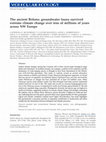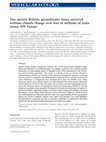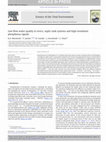Papers by Joerg Arnscheidt

Global climate changes during the Cenozoic (65.5-0 Ma) caused major biological range shifts and e... more Global climate changes during the Cenozoic (65.5-0 Ma) caused major biological range shifts and extinctions. In northern Europe, for example, a pattern of few endemics and the dominance of wide-ranging species is thought to have been determined by the Pleistocene (2.59-0.01 Ma) glaciations. This study, in contrast, reveals an ancient subsurface fauna endemic to Britain and Ireland. Using a Bayesian phylogenetic approach, we found that two species of stygobitic invertebrates (genus Niphargus) have not only survived the entire Pleistocene in refugia but have persisted for at least 19.5 million years. Other Niphargus species form distinct cryptic taxa that diverged from their nearest continental relative between 5.6 and 1.0 Ma. The study also reveals an unusual biogeographical pattern in the Niphargus genus. It originated in north-west Europe approximately 87 Ma and underwent a gradual range expansion. Phylogenetic diversity and species age are highest in north-west Europe, suggesting resilience to extreme climate change and strongly contrasting the patterns seen in surface fauna. However, species diversity is highest in south-east Europe, indicating that once the genus spread to these areas (approximately 25 Ma), geomorphological and climatic conditions enabled much higher diversification. Our study highlights that groundwater ecosystems provide an important contribution to biodiversity and offers insight into the interactions between biological and climatic processes.

Hydrology and Earth System Sciences, Jan 26, 2015
This study reports the use of high-resolution water quality monitoring to assess the influence of... more This study reports the use of high-resolution water quality monitoring to assess the influence of changes in land use management on total phosphorus (TP) transfers in two 5 km 2 agricultural sub-catchments. Specifically, the work investigates the issue of agricultural soil P management and subsequent diffuse transfers at high river flows over a 5-year timescale. The work also investigates the phenomenon of low flow P pollution from septic tank systems (STSs) and mitigation efforts -a key concern for catchment management. Results showed an inconsistent response to soil P management over 5 years with one catchment showing a convergence to optimum P concentrations and the other an overall increase. Both catchments indicated an overall increase in P concentration in defined high flow ranges. Low flow P concentration showed little change or higher P concentrations in defined low flow ranges despite replacement of defective systems and this is possibly due to a number of confounding reasons including increased housing densities due to new-builds. The work indicates fractured responses to catchment management advice and mitigation and that the short to medium term may be an insufficient time to expect the full implementation of policies (here defined as convergence to optimum soil P concentration and mitigation of STSs) and also to gauge their effectiveness.

Environmental Science Technology, Feb 7, 2013
Flow responsive passive samplers offer considerable potential in nutrient monitoring in catchment... more Flow responsive passive samplers offer considerable potential in nutrient monitoring in catchments; bridging the gap between the intermittency of grab sampling and the high cost of automated monitoring systems. A commercially available passive sampler was evaluated in a number of river systems encapsulating a gradient in storm response, combinations of diffuse and point source pressures, and levels of phosphorus and nitrogen concentrations. Phosphorus and nitrogen are sequestered to a resin matrix in a permeable cartridge positioned in line with streamflow. A salt tracer dissolves in proportion to advective flow through the cartridge. Multiple deployments of different cartridge types were undertaken and the recovery of P and N compared with the flow-weighted mean concentration (FWMC) from high-resolution bank-side analysers at each site. Results from the passive samplers were variable and largely underestimated the FWMC derived from the bank-side analysers. Laboratory tests using ambient river samples indicated good replication of advective throughflow using pumped water, although this appeared not to be a good analogue of river conditions where flow divergence was possible. Laboratory tests also showed good nutrient retention but not elution and these issues appeared to combine to limit the utility in ambient river systems at the small catchment scale.
Groundwater fauna has very specific characteristics that set it far apart from taxonomically rela... more Groundwater fauna has very specific characteristics that set it far apart from taxonomically related freshwater organisms in surface environments. In spite of some regional advances groundwater biodiversity remains poorly studied on a world wide scale. There is certainly a huge knowledge gap with regard to Asian groundwater fauna. Although scientific investigation already has revealed a very high biodiversity especially in Southeast Asian surface water environments, knowledge of subterranean aquatic fauna still remains scarce. Investigative efforts so far seem to have focussed on relatively few sites, mostly caves. Based on experience from Ireland, surveys of rural dug wells and boreholes could be a cost effective alternative that would rapidly advance the knowledge of biodiversity in Asian groundwater fauna in large areas.
Effects of anthropogenic acidification on degradation of benthic macro-invertebrate communities i... more Effects of anthropogenic acidification on degradation of benthic macro-invertebrate communities in headwater streams of the Erzgebirge region (Saxony, Germany) were investigated. For this, adults of Ephemeroptera, Trichoptera and Plecoptera were caught in 1994 and 1995 by emergence traps at four sites north of the Fichtelberg peak. Chemical monitoring classified the stream sites as episodically weakly acidic. Comparison with faunal records from 1959–1964 and from 1970 onward suggest that pH-regime has not changed drastically from 1960 to 1995, even though the first signs of forest decline for this area were recorded between 1960 and 1980.
Nach erstmaligen Larvenfunden der Gattung Hydroptila 1994 im sächsischen Abschnitt der El be konn... more Nach erstmaligen Larvenfunden der Gattung Hydroptila 1994 im sächsischen Abschnitt der El be konnten nun aus Aquarienaufzuchten Imagines als Hydroptila angulata M o s e l y bestimmt werden.

Hydrology and Earth System Sciences, 2015
This study reports the use of high-resolution water quality monitoring to assess the influence of... more This study reports the use of high-resolution water quality monitoring to assess the influence of changes in land use management on total phosphorus (TP) transfers in two 5 km 2 agricultural sub-catchments. Specifically, the work investigates the issue of agricultural soil P management and subsequent diffuse transfers at high river flows over a 5-year timescale. The work also investigates the phenomenon of low flow P pollution from septic tank systems (STSs) and mitigation efforts -a key concern for catchment management. Results showed an inconsistent response to soil P management over 5 years with one catchment showing a convergence to optimum P concentrations and the other an overall increase. Both catchments indicated an overall increase in P concentration in defined high flow ranges. Low flow P concentration showed little change or higher P concentrations in defined low flow ranges despite replacement of defective systems and this is possibly due to a number of confounding reasons including increased housing densities due to new-builds. The work indicates fractured responses to catchment management advice and mitigation and that the short to medium term may be an insufficient time to expect the full implementation of policies (here defined as convergence to optimum soil P concentration and mitigation of STSs) and also to gauge their effectiveness.

Molecular ecology, 2014
Global climate changes during the Cenozoic (65.5-0 Ma) caused major biological range shifts and e... more Global climate changes during the Cenozoic (65.5-0 Ma) caused major biological range shifts and extinctions. In northern Europe, for example, a pattern of few endemics and the dominance of wide-ranging species is thought to have been determined by the Pleistocene (2.59-0.01 Ma) glaciations. This study, in contrast, reveals an ancient subsurface fauna endemic to Britain and Ireland. Using a Bayesian phylogenetic approach, we found that two species of stygobitic invertebrates (genus Niphargus) have not only survived the entire Pleistocene in refugia but have persisted for at least 19.5 million years. Other Niphargus species form distinct cryptic taxa that diverged from their nearest continental relative between 5.6 and 1.0 Ma. The study also reveals an unusual biogeographical pattern in the Niphargus genus. It originated in north-west Europe approximately 87 Ma and underwent a gradual range expansion. Phylogenetic diversity and species age are highest in north-west Europe, suggesting ...

Environmental Science & Technology, 2013
Flow responsive passive samplers offer considerable potential in nutrient monitoring in catchment... more Flow responsive passive samplers offer considerable potential in nutrient monitoring in catchments; bridging the gap between the intermittency of grab sampling and the high cost of automated monitoring systems. A commercially available passive sampler was evaluated in a number of river systems encapsulating a gradient in storm response, combinations of diffuse and point source pressures, and levels of phosphorus and nitrogen concentrations. Phosphorus and nitrogen are sequestered to a resin matrix in a permeable cartridge positioned in line with streamflow. A salt tracer dissolves in proportion to advective flow through the cartridge. Multiple deployments of different cartridge types were undertaken and the recovery of P and N compared with the flow-weighted mean concentration (FWMC) from high-resolution bank-side analysers at each site. Results from the passive samplers were variable and largely underestimated the FWMC derived from the bank-side analysers. Laboratory tests using ambient river samples indicated good replication of advective throughflow using pumped water, although this appeared not to be a good analogue of river conditions where flow divergence was possible. Laboratory tests also showed good nutrient retention but not elution and these issues appeared to combine to limit the utility in ambient river systems at the small catchment scale.

Science of The Total Environment, 2011
Rural point sources of phosphorus (P), including septic tank systems, provide a small part of the... more Rural point sources of phosphorus (P), including septic tank systems, provide a small part of the overall phosphorus budget to surface waters in agricultural catchments but can have a disproportionate impact on the low flow P concentration of receiving rivers. This has particular importance as the discharges are approximately constant into receiving waters and these have restricted dilution capacity during ecologically sensitive summer periods. In this study, a number of identified high impact septic systems were replaced with modern sequential batch reactors in three rural catchments during a monitoring period of 4 years. Sub-hourly P monitoring was conducted using bankside-analysers. Results show that strategic replacement of defective septic tank systems with modern systems and polishing filters decreased the low flow P concentration of one catchment stream by 0.032 mg TP L − 1 (0.018 mg TRP L − 1 ) over the 4 years. However two of the catchment mitigation efforts were offset by continued new-builds that increased the density of septic systems from 3.4 km − 2 to 4.6 km − 2 and 13.8 km −2 to 17.2 km − 2 and subsequently increased low flow P concentrations. Future considerations for septic system mitigation should include catchment carrying capacity as well as technology changes.
In August 2015, more than 600 dead crayfish were reported from the Erne River system in County Ca... more In August 2015, more than 600 dead crayfish were reported from the Erne River system in County Cavan, Republic of Ireland. Analysis of a later sample of dead crayfish from the site confirmed the presence of crayfish plague, Aphanomyces astaci, a waterborne microbial parasite, whose strains usually lead to deadly infections and widespread population crashes in Europe's native crayfish species.
The Ulster Blackwater River has a cross-border catchment and is one of the major inflowing rivers... more The Ulster Blackwater River has a cross-border catchment and is one of the major inflowing rivers of Lough Neagh. It is a traditional salmon fishery that has been impacted by channelisation and eutrophication. There is evidence linking agricultural soils as sources of acute mass phosphorus transfer to the river system during storm events and chronic phosphorus transfers from other sources compound this during non-storm periods. Management of this particular impact is being demonstrated in a project in three 5km2 sub-catchments of the Blackwater River. The aims are to define and mitigate against both acute and chronic phosphorus transfers and to focus this management within a landscape framework. This work integrates agricultural stakeholders with scientists and a tripartite organization of local jurisdictions. Keywords: eutrophication; phosphorus; catchments
Hydrology and Earth System Sciences, 2005
... Wexford, Ireland, 90 pp. (EPA report 2000-LS-2.1.7-M2). Jordan, P., Menary, W., Daly, K., Kie... more ... Wexford, Ireland, 90 pp. (EPA report 2000-LS-2.1.7-M2). Jordan, P., Menary, W., Daly, K., Kiely, G., Morgan, G., Byrne, P. and Moles, R., 2005. Patterns and processes of phosphorus transfer from Irish Grassland soils to rivers-integration of laboratory and catchment strudies. ...

Science of The Total Environment, 2007
Nutrient transfers from the land to rivers have the potential to cause persistent eutrophic impac... more Nutrient transfers from the land to rivers have the potential to cause persistent eutrophic impacts at low flows even though the transfers may constitute a minor percentage of total annual fluxes. In rural catchments, the contribution from agricultural soils during storm events can be particularly large and untangling the relative contributions from multiple sources that vary in time and space is especially problematic. In this study, the potential for domestic septic tank system pollution during low flows was investigated in 3 small catchments (3 to 5 km(2)) using an integrated series of methods. These included septic system surveys, continuous (10 min) total phosphorus (TP) monitoring at the outlet of each catchment, repeated low-flow water quality surveys in sub-catchments upstream of the catchment outlets and single day river-walk water quality surveys. A series of faecal matter and grey-water fingerprinting techniques were also employed. These included determining sterol ratios in stream sediments, monitoring the presence of proteins, E. coli and enterococci bacterial signatures and boron. The total density and density of poorly maintained septic systems mirrored the magnitude of frequent TP concentrations in the catchments although this relationship was less apparent in the nested sub-catchments. The exception was possibly related to the simple hydraulics in one particular catchment and indicated temporary effluent attenuation in the other catchments. Repeated low-flow and river-walk water quality surveys highlighted discrete areas and reaches where stepped changes in nutrient concentration occurred. Bio-chemical fingerprinting showed that between 7% and 27% of sediments were contaminated with human faecal material and correlation matrices indicated that, at least during low flows, P fractions were positively correlated with some markers of faecal and grey-water contamination.

The uncertainties associated with stream nutrient transport estimates are frequently overlooked a... more The uncertainties associated with stream nutrient transport estimates are frequently overlooked and the sampling strategy is rarely if ever investigated. Indeed, the impact of sampling strategy and estimation method on the bias and precision of stream phosphorus (P) transport calculations is little understood despite the use of such values in the calibration and testing of models of phosphorus transport. The objectives of this research were to investigate the variability and uncertainty in the estimates of total phosphorus transfers at an intensively monitored agricultural catchment. The Oona Water which is located in the Irish border region, is part of a long term monitoring program focusing on water quality. The Oona Water is a rural river catchment with grassland agriculture and scattered dwelling houses and has been monitored for total phosphorus (TP) at 10 min resolution for several years (Jordan et al, 2007). Concurrent sensitive measurements of discharge are also collected. The water quality and discharge data were provided at 1 hour resolution (averaged) and this meant that a robust estimate of the annual flow weighted concentration could be obtained by simple interpolation between points. A two-strata approach (Kronvang and Bruhn, 1996) was used to estimate flow weighted concentrations using randomly sampled storm events from the 400 identified within the time series and also base flow concentrations. Using a random stratified sampling approach for the selection of events, a series ranging from 10 through to the full 400 were used, each time generating a flow weighted mean using a load-discharge relationship identified through log-log regression and monte-carlo simulation. These values were then compared to the observed total phosphorus concentration for the catchment. Analysis of these results show the impact of sampling strategy, the inherent bias in any estimate of phosphorus concentrations and the uncertainty associated with such estimates. The estimates generated using the full time series underestimate the flow weighted mean concentration of total phosphorus. This work compliments other contemporary work in the area of load estimation uncertainty in the UK (Johnes, 2007). Johnes P,J. 2007, Uncertainties in annual riverine phosphorus load estimation: Impact of load estimation methodology, sampling frequency, baseflow index and catchment population density, Journal of hydrology 332 (1- 2): 241-258 Jordan, P., Arnscheidt, J., McGrogan, H & McCormick, S., 2007. Characterising phosphorus transfers in rural transfers using a continuous bank-side analyser. Hydrology and Earth System Science 11, 372-381 Kronvang B & Bruhn, A. J, 1996. Choice of sampling strategy and estimation method for calculating nitrogen and phosphorus transport in small lowland streams , Hydrological processes 10 (11): 1483-1501






Uploads
Papers by Joerg Arnscheidt